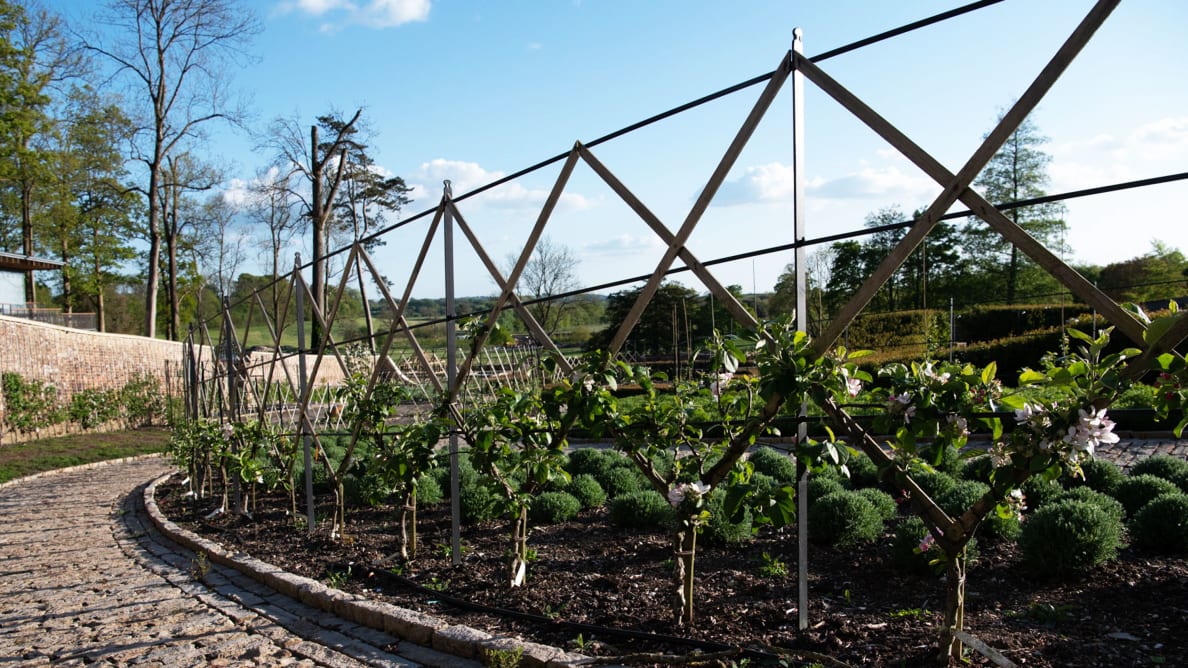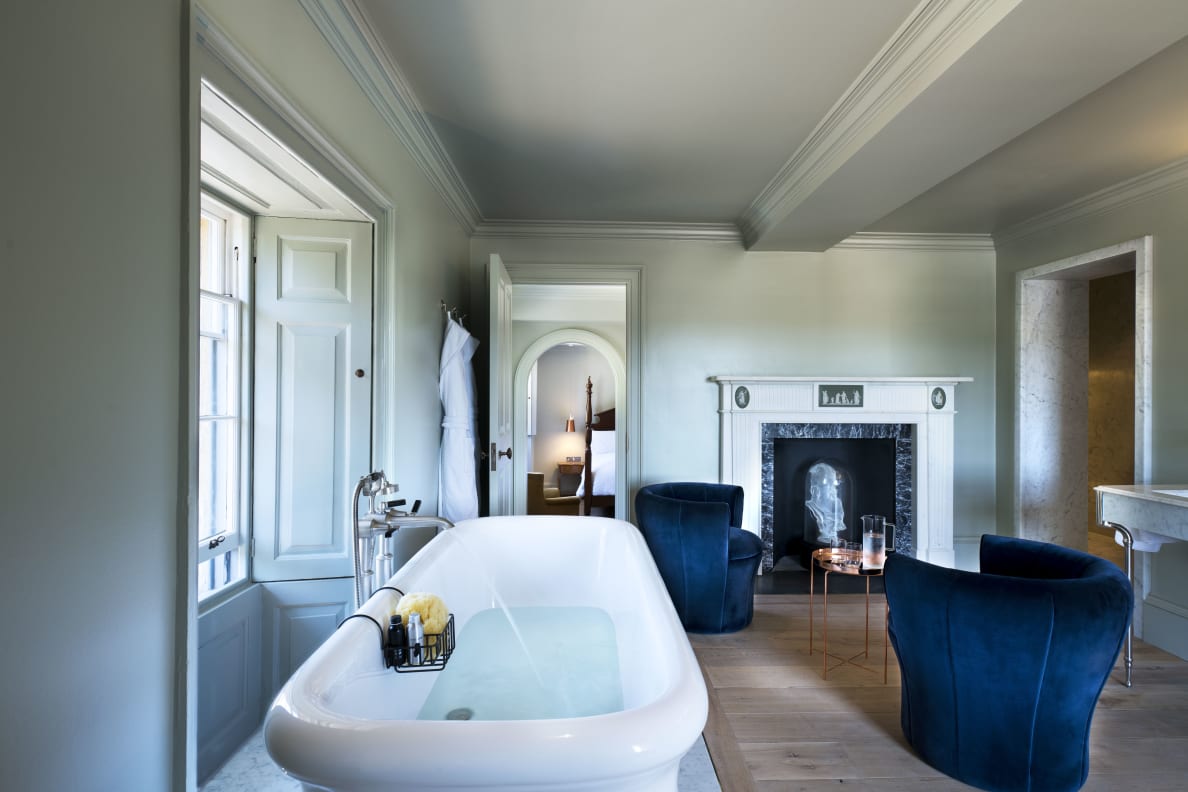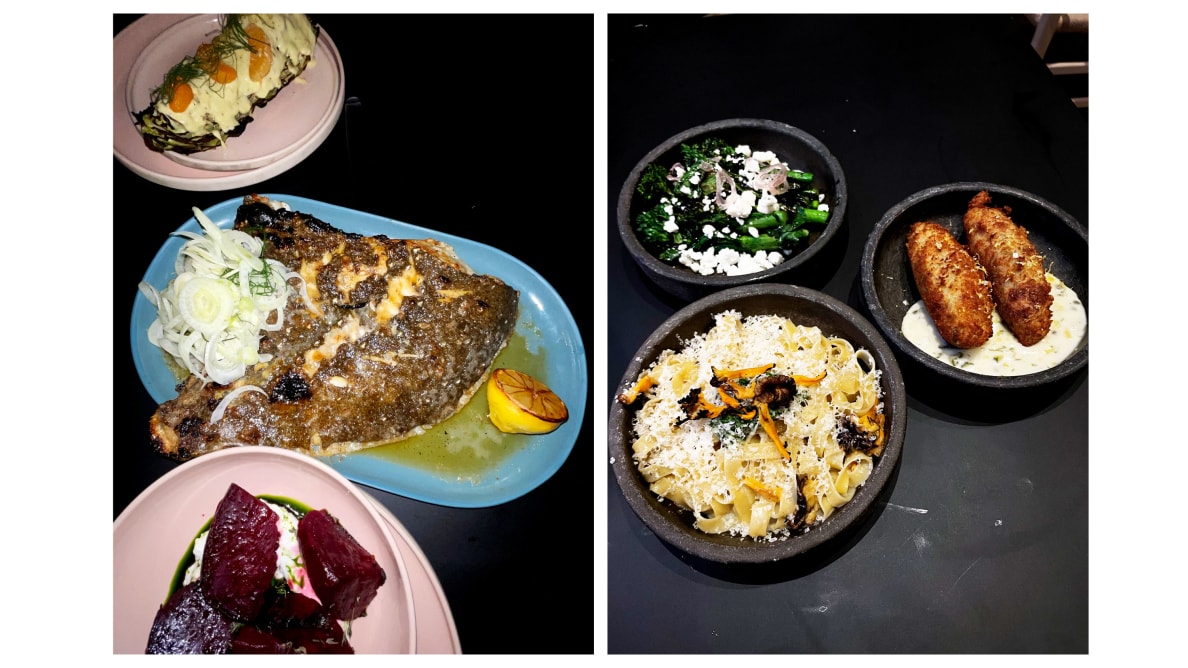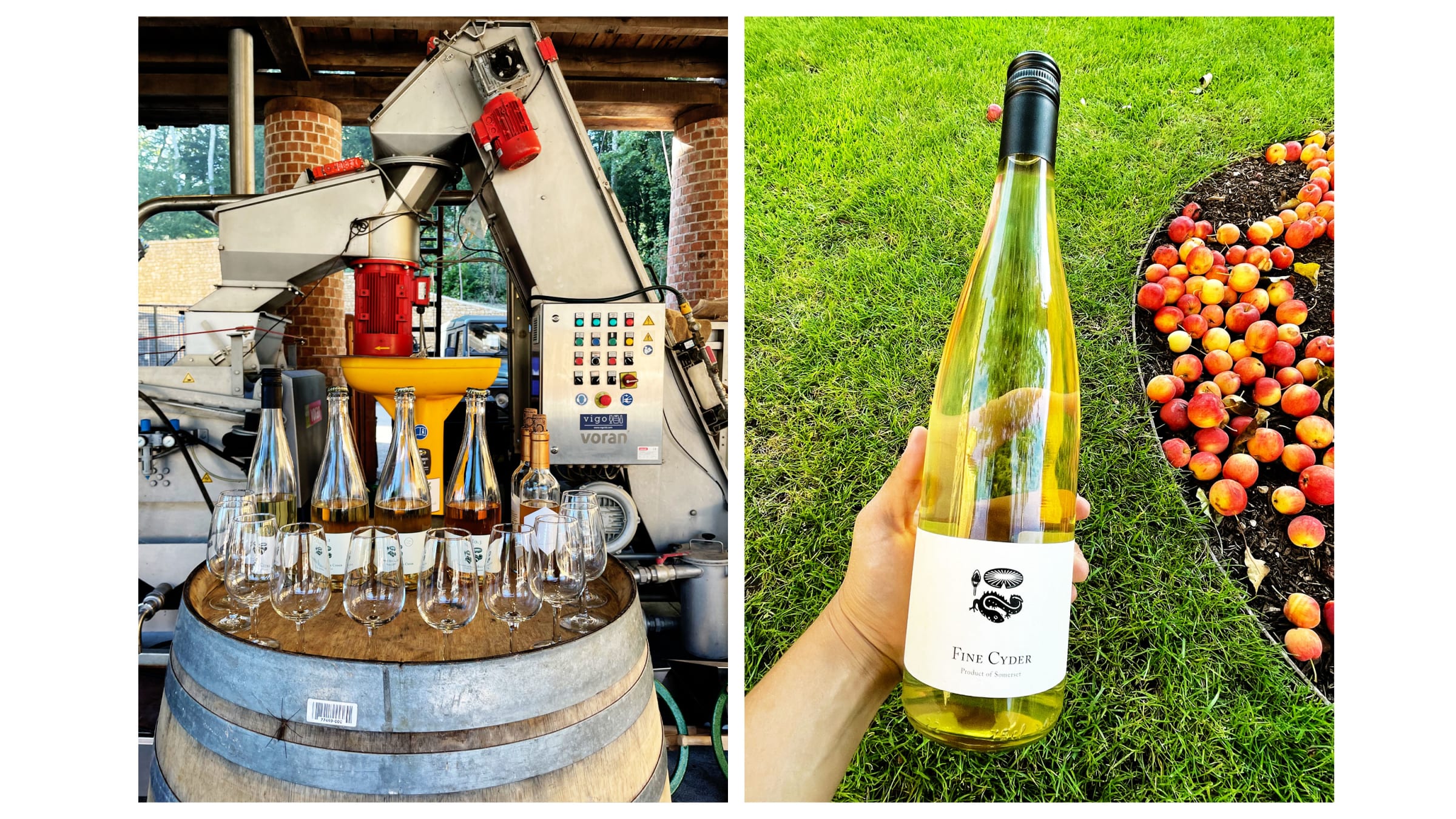This English Country Estate Has a Peculiar Amenity

The Newt in Somerset
Sure, it has the classic Georgian manse, rolling hills, and a working farm. But how many places have a replica Roman villa?
I’ll admit I had never stayed at a mansion that boasts a fourth century Roman villa onsite. In fact, most of us probably haven’t. But unlike any other property in the U.K., The Newt, a Georgian house turned hotel, has the preserved ruins of an ancient Roman villa dating back to 351 A.D. on the property.
Nestled in the hills between Brutton and Castle Cary, and a short stop away from Stonehenge and Bath, The Newt in Somerset gives you just about everything an American could want in their British country getaway: technicolor landscapes with grazing sheep that are completely real (no artificial coloring goes into this grass), farm-to-table restaurants, historical lodging with modern amenities, a spa, pool, Beezantium, apple trees, and gardens.
When Ric Weeks, on-site archaeologist at the Roman villa, walked us through the ruins it was hard not to be in awe of the physical remains of Romano-British history and rare archaeological findings that lay onsite. Recent archeological excavations have revealed the details of the early Roman baths. However, the most gripping element of the site is the recreation of the villa that the hotel constructed across from the ruins.

Reconstruction of a triclinium, or dining room, in Villa Ventorum at The Newt in Somerset.
The Newt in Somerset

The vestibulum, or entrance hall, of Villa Ventorum at The Newt in Somerset, with its hand-painted interiors.
The Newt in Somerset
The Romano-British villa and museum opened its doors to the public this past June and the recreation shows you more than a floor plan could ever reveal. Their efforts included finding a person in Italy who makes roofing tiles individually using his thigh just as they would have been created during this era. As an added bonus, for those who love tech, there is a VR experience that takes you through an in-person perspective on how the space was used by Romans in Somerset centuries ago.

Surviving 4th-century mosaics on display in the Roman Villa Museum at The Newt in Somerset.
The Newt in Somerset

Villa Ventorum, “Villa of The Winds,” The Roman Villa Experience at The Newt in Somerset.
The Newt in Somerset
For three days, I stayed at and explored The Newt which originally opened in 2019. The hotel offers guests the option of staying in Hadspen House, a Georgian manor dating back to 1690 or the refurbished 18th century dairy farm and granary on the 300 acre estate.

A welcome gate to The Newt in Somerset’s Hadspen House.
The Newt in Somerset
My first night I stayed at the Hadspen House, a warm golden manse made of sandstone. This property was originally a gentleman’s house built by William Player at the cost of £1,000 which included a barn, stables, and private courtyards. Today, it houses a collection of lounges, 23 guest rooms with en suite bathrooms, and The Botanical Room Restaurant.

The Bar at The Newt in Somerset, located in Hadspen House.
The Newt in Somerset
Every inch of the manor smelled of fresh herbs, just as it would have in 1785 when Henry Hobhouse ll, a garden enthusiast, bought it and transformed the estate by creating the ‘D-garden’, an original kitchen garden development inspired by a Baroque-style hedge apple tree maze that was later renamed the Parabola. This was used to grow an abundance of herbs, fruits, and vegetables used by the staff and chefs at restaurants on site.

Trained apple trees in the Parabola Garden at The Newt in Somerset.
The Newt in Somerset
Portrait paintings of the Hobhouse family are dispersed throughout the Croquet Lounge Bar and the Library. The Croquet Lounge was by far one of my favorite rooms to relax in. The level of natural light is exceptional as are the vibrant hues and earthy scent radiating from the plants throughout the space. You can exit the lounge and find yourself immediately in the midst of a croquet game on the lawn where you can join in or take notes if, like me, you are not familiar with the rules.

The Croquet Room at The Newt in Somerset
The Newt in Somerset

Croquet area at The Newt in Somerset.
Kelly Caminero/The Daily Beast
In the Library guests can enjoy a cup of tea as they are greeted with an exuberant interior design heavily inspired by a Georgian family home with a youthful twist. A dynamic cool palette of blues, greens, and magenta occupies the space balancing the owner’s appreciation for nature and authenticity.

Exterior view of the Hadspen House at The Newt in Somerset.
Kelly Caminero/The Daily Beast

Ensuite bathroom in one of The Newt’s Hadspen House rooms.
The Newt in Somerset
I stayed in the Hadspen Cosy Room, located in part of the original manor house. The room itself was both picturesque and comforting. Every part of the experience in my room was well calculated: predetermined playlist options that I could play throughout the space, a bathtub I could sink into, fresh fruit from the garden to snack on with a view of a flock of sassy diva sheep simply living their best life.

Sheep on the road at The Newt in Somerset.
Courtesy of Kenan Hunter
On the first night, dinner was organized in The Botanical Room. As I entered, I was welcomed with the fresh produce pulled from the various gardens on the estate that day. Head Chef Ben Champkin provides a unique seasonal dining experience, as all of the meals tasted like a home cooked meal, baked in with the historical context of a working estate producing food farm-to-table from centuries prior. Some key favorites were the scallops, day boat fish with purple sprouting broccoli & smoked cod roe, and their baked dark chocolate, cocoa sorbet & sourdough gelato.
The next morning, I took a step outside and enjoyed the multitude of amenities the estate has to offer.
I began where anyone should start any trip; at the spa. I cozied up in the jacuzzi, felt steam coat my body in the steam room, and topped it off with an out-of-body experience with their Hammam Spa Soap treatment.

The Hammam Steam Chamber at the Spa at The Newt in Somerset
The Newt in Somerset

The indoor-outdoor Spa pool at The Newt in Somerset’s Hadspen House.
The Newt in Somerset
Afterwards, I took a walk through their immense gardens that transported me through thousands of years of history, discovering how Roman ancestors gardened as well as other gardening techniques throughout the world. The estate prides itself on using most if not all authentic local ingredients. For example, the produce garden offers more than 350 varieties of fresh fruit and vegetables, all of which are used for breakfast, lunch, and dinner in The Botanical Rooms, Garden Café, and Farmyard Kitchen. I learned if you’re lucky, you may see a newt or two; hence how The Newt earned its name.

Newt Pond at The Newt in Somerset.
Kelly Caminero/The Daily Beast
No newts for me, but I was lucky to see something else; bees, and a lot of them. The on-site international bee expert, Paula Carnell, the head beekeeper at The Newt in Somerset, spearheads a bee safari and honey tasting experience at The Newt. Carnell walks guests through the Threshing Barn for a short 10 minute walk to the Beezantium, a habitation for wild bee colonies. She elaborates on the connections between bees, nature, and humans by providing an overview of efforts she and the estate make to ensure a safe environment for the bees. It was fascinating to learn the process in which a queen bee is selected. Learning that the life of a future queen bee is in the hands of the worker bees and also up to chance was both captivating and eye opening. The worker bees will separate prospective queen bees into separate cells located in the hive. There, the future queen bees are fed larvae exclusively by the worker bees. The larvae comes from hatched worker bee eggs in a 3 day period. Then, the first to mature becomes the queen. The Beezantium on site offers an even more up-close, tech-savvy look at bee life in Somerset with an educational and immersive headset experience.
That evening, I ventured to the other side of the property and stayed at the Farmyard. With 17 rooms, this former dairy farm souped up with slick glass and steel elements feels like you’re stepping into the home of a cool-and-wealthy-aunt-you-don’t-have who starred on Grand Designs. In the center of the farmyard rooms lies a separate building with alcoholic and nonalcoholic beverages and desserts guests and insomniacs like myself can access at any time, a pool and jacuzzi tiptoe distance from your room, the Farmyard Kitchen, and yes, even more of that rolling English countryside to gaze.

(L to R) Day Boat Fish, Kale and Elderflower, Beetroot, Hang Op with Wild Garlic, Egg Cabbage, Broccoli, Harbourne Blue, Shallot, and Salt Fish Croquettes with a tartare sauce at The Farmyard Kitchen at The Newt in Somerset.
Kelly Caminero/The Daily Beast

(L to R_ Roasted half guinea fowl, shallot and tarragon, broccoli, Harbourne blue, shallot, and green apple sorbet at The Farmyard Kitchen at The Newt in Somerset.
Kelly Caminero/The Daily Beast
Our room was breathtaking, from the exposed wooden beams on high ceilings I could yodel in to cozy stone and wood decorative elements surrounding the bed. The bathrooms featured a steam room and bathtub that I swam in.

Farmyard Room at The Newt in Somerset.
The Newt in Somerset
After an evening at the Farmyard, I was excited to dig deeper into the property’s agricultural side. I drove past the apple trees, and over to see how cider is created on the property. The cider is made from 100% apple juice, with no added sugar or water. Then, it’s steadily cold-fermented in the cellar for months, but can also span years in order to achieve the full fresh fragrant body flavor of the orchard. I do not consider myself a cider enthusiast by any stretch, but after this tasting experience I crossed paths with a cider that left an imprint on my taste buds and changed my conviction on the apple as a whole–The Fine Cider. For me it captured the sweetness you’re used to in a typical cider without the harshness of the acidity that typically creeps up in the aftertaste.

Fine cyder from the cyder tasting station.
Kelly Caminero/The Daily Beast
For lunch, I stopped by the Garden Café, where my meal was centered around fresh veggies with meats being a side offering. Like the grass, my food was in technicolor. It was incredible. Some key favorites were the Baker’s bread with estate butters, radish & Dorset sea salt, broccoli soup, and an assorted meat and cheese plate that was as delicious as colorful.

Cured Matured Board from The Garden Café at The Newt in Somerset.
Ed Schofield
The Newt is proof that a place can both look back at its history and contribute to history—the quintessential modern country house hotel now with a Roman villa to boot.
